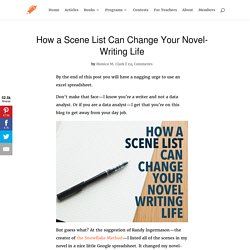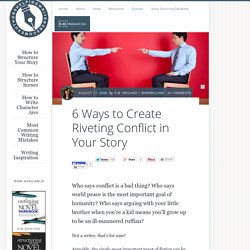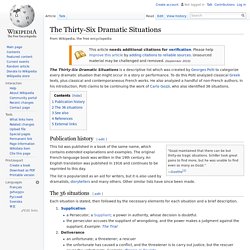

3 Types of Character Arcs: Choose the Best for Your Novel. How Does Your Character Change?

You know your character must change somehow over the course of your novel. But how? And more than that, how do you sync the changes with the external plot? Creating Stunning Character Arcs, Pt. 2: The Lie Your Character Believes. People hate change.

We may sit around and wish our lives were different, but when the rubber really starts streaking the tarmac, we usually find ourselves wishing we could just hang out here in our safe and familiar haunts. Characters are no different. How a Scene List Can Change Your Novel-Writing Life. By the end of this post you will have a nagging urge to use an excel spreadsheet.

Don’t make that face—I know you’re a writer and not a data analyst. Or if you are a data analyst—I get that you’re on this blog to get away from your day job. Elements of Suspense in Writing: 6 Secret to Creating and Sustaining Suspense. Thriller writing?

Mystery writing? Literary fiction? It’s all the same: Building apprehension in the minds of your readers is one of the most effective keys to engaging them early in your novel and keeping them flipping pages late into the night. How To Create An Intriguing Inciting Incident. Every single element between the first page and the very last page of a screenplay is arguably the most important, salable thing about it.

In this article, the beginning of the plot takes the number one spot. However, the plot really can’t begin being awesome until it is set in motion. That’s where the inciting event comes in. A good plot is everything that transpires in the screenplay and, if it’s captivating, will have an equally captivating inciting event. But good inciting events don’t come easy. 6 Ways to Create Riveting Conflict in Your Story. Who says conflict is a bad thing?

Who says world peace is the most important goal of humanity? Who says arguing with your little brother when you’re a kid means you’ll grow up to be an ill-mannered ruffian? Not a writer, that’s for sure! Monomyth. Joseph Campbell's monomyth, or the hero's journey, is a basic pattern that its proponents argue is found in many narratives from around the world.

This widely distributed pattern was described by Campbell in The Hero with a Thousand Faces (1949).[1] Campbell, an enthusiast of novelist James Joyce, borrowed the term monomyth from Joyce's Finnegans Wake.[2] Campbell held that numerous myths from disparate times and regions share fundamental structures and stages, which he summarized in The Hero with a Thousand Faces: A hero ventures forth from the world of common day into a region of supernatural wonder: fabulous forces are there encountered and a decisive victory is won: the hero comes back from this mysterious adventure with the power to bestow boons on his fellow man.[3]
How to Rock Your Story's Tension. Photo cred: © Sergei Zolkin via Unsplash Today we’re talkin’ tension.

No matter your story’s plot or genre, you need to know how to nail tension in your fiction. The Subplot - Not Second Place, but Side by Side. There is one element in plotting our story that we sometimes forget or neglect—the subplot.

The subplot is what rounds out a novel or screenplay, informing it with another shade of emotional colour to deliver a satisfying and entertaining experience. It is the parallel narrative that allows the writer to explore theme, deepen characterisation, add tension or allow some relief. The subplot helps us understand the characters a bit better and gives a better sense of pace. Love and other pursuits. The Thirty-Six Dramatic Situations. The Thirty-Six Dramatic Situations is a descriptive list which was created by Georges Polti to categorize every dramatic situation that might occur in a story or performance.

To do this Polti analyzed classical Greek texts, plus classical and contemporaneous French works. He also analyzed a handful of non-French authors. In his introduction, Polti claims to be continuing the work of Carlo Gozzi, who also identified 36 situations. Publication history[edit] “Gozzi maintained that there can be but thirty-six tragic situations. Damn it Neil, the name is Nuwanda. How to Deliver Bad News in Writing. While you can't turn bad news into good through clever wording, the way that you deliver bad news in writing can affect how it is received the same way that it does when speaking. Some speakers know how to deliver bad news, and others only make it worse. The same is true in writing. The introduction is very important. It sets the context for the bad news, and context has a lot to do with how bad news is received. Instead of jumping straight into the bad, try leading with something positive. Historical Romance Author Robyn DeHart, Legend Hunters , Ladies Amateur Sleuth Society.
Theme & Premise: Or How to Plot a Character Driven Book in 3 Easy Steps It is said that there are two types of writers: plotters and seat of the pants writers (or fly into the mist writers). Obviously the majority of us fall somewhere in between. Writing Fiction: How to Structure a Killer Novel Ending. There are more than a few writers and teachers out there, many of them orders of magnitude more famous than I am (not hard to do), who don’t like to compartmentalize or even attempt to define the sequential parts and essential milestones of a story’s plot structure.
Too formulaic, they say. Takes the fun and creativity out of it, they claim. A write-by-the-numbers strategy for hacks, a vocal few plead. Conflicts in Literature. A Writer’s Cheatsheet to Plot and Structure. How to Structure A Story: The Eight-Point Arc. By Ali Hale - 3 minute read One of my favourite “how to write” books is Nigel Watts’ Writing A Novel and Getting Published. My battered, torn and heavily-pencil-marked copy is a testament to how useful I’ve found it over the years. Although the cover appears to be on the verge of falling off altogether, I’ve risked opening the book once more to bring you Watts’ very useful “Eight-Point Story Arc” – a fool-proof, fail-safe and time-honoured way to structure a story. (Even if you’re a short story writer or flash fiction writer rather than a novelist, this structure still applies, so don’t be put off by the title of Watts’ book.) The eight points which Watts lists are, in order: